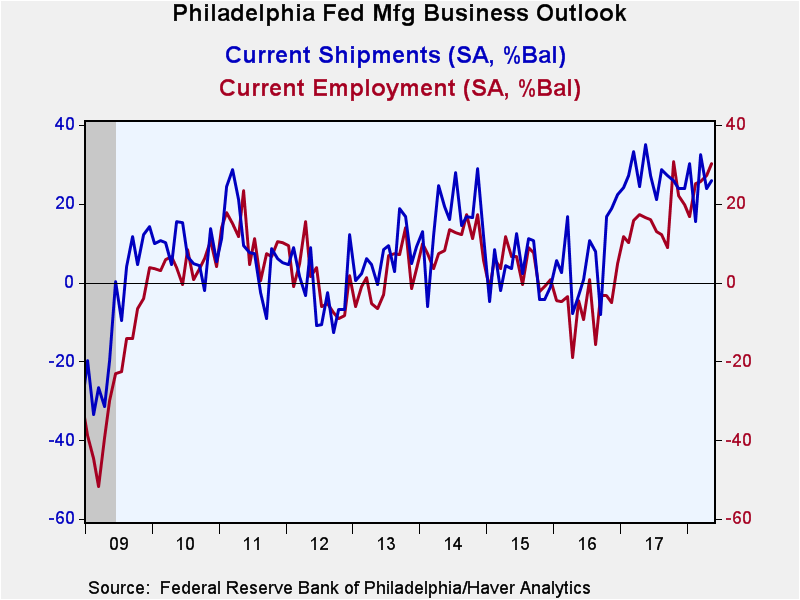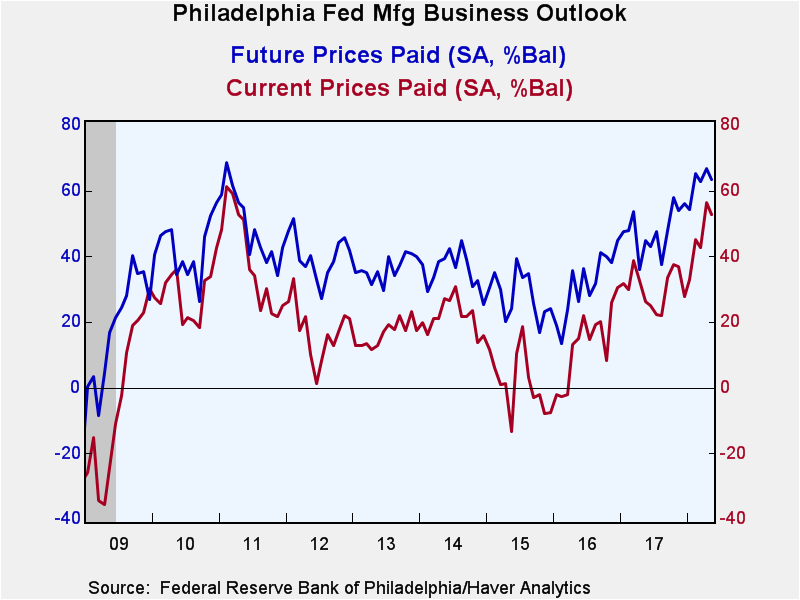 Global| May 17 2018
Global| May 17 2018Philadelphia Fed Factory Conditions Surge; Prices Paid Retreat
Summary
The Philadelphia Federal Reserve reported that its General Factory Sector Business Conditions Index jumped to 34.4 during May, the highest level in a year. Expectations had been for a reading of 21.0 in the Action Economics Forecast [...]
The Philadelphia Federal Reserve reported that its General Factory Sector Business Conditions Index jumped to 34.4 during May, the highest level in a year. Expectations had been for a reading of 21.0 in the Action Economics Forecast Survey. The number of firms reporting an improvement in business activity rose to 43.2% from 36.9% while the number reporting a worsening declined to 8.8% from 13.7%. As a diffusion index, readings above zero indicate expansion.
Haver Analytics constructs an ISM-Adjusted General Business Conditions Index. This measure strengthened this month to 61.6, close to March's 30-year high reading of 61.9. During the last ten years, there has been a 67% correlation between the quarterly ISM-adjusted Philadelphia Fed Index and quarterly real GDP growth
A surge in new orders to 40.6 -- the highest reading in 45 years -- drove the gain in the composite index. Shipments and employment also improved, while delivery times and inventories declined. Unfilled orders, which is not part of the ISM-Adjusted index, rose.
The employment index rose to 30.2, near the September 2017 record of 30.7. During the last ten years, there has been an 81% correlation between the index level and the month-to-month change in manufacturing employment. The share of firms reporting a rising level of payrolls increased to a record 36.7%, but this was somewhat offset by an increase in layoffs. The average workweek series surged to a record 34.4.
The prices paid index declined to 52.6 after reaching an eight-year high in April, though remains quite elevated. The percent of respondents reporting higher prices decreased to a still lofty 54.6%, while just 2.0% paid lower prices. The index of prices received rose to 36.4, the highest level in 29 years.
The future activity index declined to 38.7, its lowest level in eleven months. Shipments, delivery times, inventories and prices paid decreased, while new and unfilled orders as well as employment rose.
The survey panel consists of 150 manufacturing companies in the third Federal Reserve District (which consists of southeastern PA, southern NJ and Delaware). The diffusion indexes represent the percentage of respondents indicating an increase minus the percentage indicating a decrease in activity. The ISM-adjusted figure, calculated by Haver Analytics, is the average of five diffusion indexes: new orders, shipments, employment, delivery times and inventories with equal weights (20% each). Each ISM-adjusted index is the sum of the percent responding "higher" and one-half of the percent responding "same."
The figures from the Philadelphia Federal Reserve dating back to 1968 can be found in Haver's SURVEYS database. The expectation from the Action Economics Forecast Survey is available in AS1REPNA.
| Philadelphia Fed - Manufacturing Business Outlook Survey (%, SA) | May | Apr | Mar | May'17 | 2017 | 2016 | 2015 |
|---|---|---|---|---|---|---|---|
| General Factory Sector Business Conditions | 34.4 | 23.2 | 22.3 | 35.5 | 27.4 | 4.9 | 3.7 |
| ISM-Adjusted Business Conditions | 61.6 | 59.7 | 61.9 | 57.6 | 57.2 | 48.3 | 49.4 |
| New Orders | 40.6 | 18.4 | 35.7 | 24.7 | 25.4 | 4.9 | 3.0 |
| Shipments | 25.8 | 23.9 | 32.4 | 35.0 | 26.8 | 6.9 | 3.0 |
| Unfilled Orders | 15.3 | 7.8 | 20.1 | 9.6 | 11.9 | -5.6 | -5.1 |
| Delivery Time | 18.5 | 20.7 | 14.0 | 7.5 | 10.6 | -4.6 | -4.2 |
| Inventories | 8.1 | 9.5 | 16.5 | 2.5 | 2.8 | -9.6 | -1.4 |
| Number of Employees | 30.2 | 27.1 | 25.6 | 16.5 | 16.2 | -5.6 | 3.9 |
| Average Workweek | 34.4 | 21.6 | 12.8 | 18.9 | 14.9 | -5.4 | -1.7 |
| Prices Paid | 52.6 | 56.4 | 42.6 | 26.3 | 30.4 | 13.5 | 1.5 |
| Expectations - General Business Conditions; Six Months Ahead | 38.7 | 40.7 | 47.9 | 37.9 | 47.1 | 33.7 | 37.6 |
Gerald D. Cohen
AuthorMore in Author Profile »Gerald Cohen provides strategic vision and leadership of the translational economic research and policy initiatives at the Kenan Institute of Private Enterprise.
He has worked in both the public and private sectors focusing on the intersection between financial markets and economic fundamentals. He was a Senior Economist at Haver Analytics from January 2019 to February 2021. During the Obama Administration Gerald was Deputy Assistant Secretary for Macroeconomic Analysis at the U.S. Department of Treasury where he helped formulate and evaluate the impact of policy proposals on the U.S. economy. Prior to Treasury, he co-managed a global macro fund at Ziff Brothers Investments.
Gerald holds a bachelor’s of science from the Massachusetts Institute of Technology and a Ph.D. in Economics from Harvard University and is a contributing author to 30-Second Money as well as a co-author of Political Cycles and the Macroeconomy.









